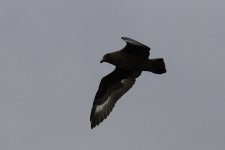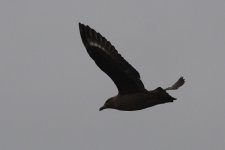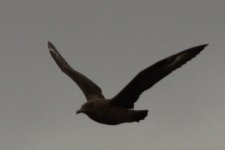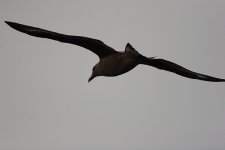-
Welcome to BirdForum, the internet's largest birding community with thousands of members from all over the world. The forums are dedicated to wild birds, birding, binoculars and equipment and all that goes with it.
Please register for an account to take part in the discussions in the forum, post your pictures in the gallery and more.
You are using an out of date browser. It may not display this or other websites correctly.
You should upgrade or use an alternative browser.
You should upgrade or use an alternative browser.
Aussie sea bird (1 Viewer)
- Thread starter jimmclean
- Start date
More options
Who Replied?London Birder
Well-known member
it's a skua Jim, now what sort ...
Jane Turner
Well-known member
To be even more precise its a Catharacta skua, I think we need to let the Antipodean experts loose on this. Looks promsing for South Polar, but to be honest I have no clue what is likely down there.
gerdwichers8
Well-known member
Lack of dark hood, contasting with paler body would rule out Great Skua.
Pale morp South Polar Skua is not in consideration. IF paler(brownish grey) streaks on neck are diagnostic for dark morph, the lack of it would rule out South Polar Skua at all. Dark morph seems to have an all dark face and not only a dark cap.
All yellow faced skuas are out without any consideration.
Chilean Skua shows even a more capped appearance than Great Skua with its buffish tone to its underbody.
I largely favour Brown Skua (Hamiltoni subspecies.)
on this one. (It shows warm brown undertone to the body; this I suppose to be a difference with South polar)
For Lonnbergi adult I would say, that particular subspecies is too pale if the shade has not taken away of the exact overall colour. But moreover.. Lonnbergi hardly hints at having a darker cap. This bird has a bit more
I dont know how the juveniles differ from the adults
I only used a given key for that. It better be checked by some of them more experienced dudes down under.
Pale morp South Polar Skua is not in consideration. IF paler(brownish grey) streaks on neck are diagnostic for dark morph, the lack of it would rule out South Polar Skua at all. Dark morph seems to have an all dark face and not only a dark cap.
All yellow faced skuas are out without any consideration.
Chilean Skua shows even a more capped appearance than Great Skua with its buffish tone to its underbody.
I largely favour Brown Skua (Hamiltoni subspecies.)
on this one. (It shows warm brown undertone to the body; this I suppose to be a difference with South polar)
For Lonnbergi adult I would say, that particular subspecies is too pale if the shade has not taken away of the exact overall colour. But moreover.. Lonnbergi hardly hints at having a darker cap. This bird has a bit more
I dont know how the juveniles differ from the adults
I only used a given key for that. It better be checked by some of them more experienced dudes down under.
Last edited:
London Birder
Well-known member
good idea ...
gerdwichers8
Well-known member
Hey Jane, you re fast on a split seccond!
James Lowther
Well-known member
i have nothing to add ID wise to this bird, but having seen a Catharacta skua in S. Australia I did some research on which types occur in aussie waters and you I think you basically get south polar (mccormickii or whatever) and brown skua (lonnbergii??).
so it's probably one of those..
so it's probably one of those..
gerdwichers8
Well-known member
After I have been going through some photo s, about Brown Skua , I found that the illustrator of the book, taken as a reference, has done a fair bit of art work.
Nevertheless, combined with those photo s it turns out that the subspecies Lonnbergi is, contrary to the illustration itself, often a dark bird. This subspecies, together with C. a. antartica, the third subspecies of Brown skua ,hardly shows a warm brown colour on the photo s as is suggested in the illustration, is neither much paler as antartica and hamiltoni as is suggested in the illustration but..even has a under colour which tends to the same kind of brown grey colour as South polar skua.
The photo is far, far of the illustration. Differences have been put too extremely and therefore, they may be much less distinctive
hamiltoni is the darkest of the three subspecies(Lonnbergi, antartica, hamiltoni) but the illustration of hamiltoni equals the photo of lonnbergi,( the palest) in a clouded background.
(Most of the photos though, have been taken with clouded weather and not in sunlight, so the illustrations will hold some value )
A difference appart of colour is size: and then this order:antartica the smallest, hamiltoni and lonnbergi
Reference: HBW Volume 3 Hoatzin to Auks
Most photographs of the species found all over the net show a defenately warm brown colour in al the three subspecies but many Brown skuas could not be specified in the third taxon. (Often not even in the second!)
A darker cap is a NOT for Lonnbergi
The bird on the sent-in-photo has a warm brown colour which is not so much found on the photo s in the book. It seems that this photo has been taken in sunlight.
So I say we have been lucky with the quality of the photo you sent in!
Nevertheless, combined with those photo s it turns out that the subspecies Lonnbergi is, contrary to the illustration itself, often a dark bird. This subspecies, together with C. a. antartica, the third subspecies of Brown skua ,hardly shows a warm brown colour on the photo s as is suggested in the illustration, is neither much paler as antartica and hamiltoni as is suggested in the illustration but..even has a under colour which tends to the same kind of brown grey colour as South polar skua.
The photo is far, far of the illustration. Differences have been put too extremely and therefore, they may be much less distinctive
hamiltoni is the darkest of the three subspecies(Lonnbergi, antartica, hamiltoni) but the illustration of hamiltoni equals the photo of lonnbergi,( the palest) in a clouded background.
(Most of the photos though, have been taken with clouded weather and not in sunlight, so the illustrations will hold some value )
A difference appart of colour is size: and then this order:antartica the smallest, hamiltoni and lonnbergi
Reference: HBW Volume 3 Hoatzin to Auks
Most photographs of the species found all over the net show a defenately warm brown colour in al the three subspecies but many Brown skuas could not be specified in the third taxon. (Often not even in the second!)
A darker cap is a NOT for Lonnbergi
The bird on the sent-in-photo has a warm brown colour which is not so much found on the photo s in the book. It seems that this photo has been taken in sunlight.
So I say we have been lucky with the quality of the photo you sent in!
Last edited:
gerdwichers8
Well-known member
But what about the bill on your picture!
It says that Chilean Skua is the only Catharacta skua with a two coloured pale blue and black tipped bill.
The rest has black bill
Sun again?
It says that Chilean Skua is the only Catharacta skua with a two coloured pale blue and black tipped bill.
The rest has black bill
Sun again?
Last edited:
doug_newman
Well-known member
According to my Simpson & Day Birds of Australia, it only shows Great and South Polar Skua for Australia and then a few Jaegers.
Great Skua does not look right and normally South Polar skua would have a pale body and even paler head but this book also shows a dark morph of South Polar Skua. How about darl morph Catharacta maccormicki? That would fit in with the birds one might expect there.
Great Skua does not look right and normally South Polar skua would have a pale body and even paler head but this book also shows a dark morph of South Polar Skua. How about darl morph Catharacta maccormicki? That would fit in with the birds one might expect there.
James Lowther
Well-known member
Simpson and Day obviously use the most conservative taxonomy where great and south polar are the only two Catharacta species so that doesn't narrow it down much doug!!

many authorities split the great skua complex up into 3 or 4 species but i think brown skua is the only one that occurs regularly in oz??
p.s. still nothing to add re: the ID - skuas are too damned hard!
many authorities split the great skua complex up into 3 or 4 species but i think brown skua is the only one that occurs regularly in oz??
p.s. still nothing to add re: the ID - skuas are too damned hard!
JANJ
Well-known member
Tricky business this!
Acording to Olsen & Larsson (1997) South Polar Skua is rare in Australia between September and June, with some return migration along Australian coasts in September, while Brown Skua Subantarctic ssp lonnbergi is quite regular in Australian waters.
jimmcleans images of the Chataracta Skuas (notice the difference in size of the white underwing 'flash') are to dark, at least on my monitor, so the only plumage characters I see, apart from wing flashes are the paler hindneck and pale bill base (paler bill base a juv/immature character of both, in this case, South Polar and Lonnbergi) which could indicate South Polar, but also juv or immature, or some adult lonnbergi. Juv/Immature South Polar apparently lack the 'golden' hindneck as shown in jimmcleans images. So perhaps lonnbergi would be the choice here, but far from easy as variation is huge!
The Brown Skua group C. antarctica has three distinct populations
Subantarctic Skua race lonnbergi subantarctic islands.
Falkland Skua race antarctica Falkland and Patagonia.
Tristan Skua race hamiltoni Tristan da Cunha and Gough.
JanJ
Acording to Olsen & Larsson (1997) South Polar Skua is rare in Australia between September and June, with some return migration along Australian coasts in September, while Brown Skua Subantarctic ssp lonnbergi is quite regular in Australian waters.
jimmcleans images of the Chataracta Skuas (notice the difference in size of the white underwing 'flash') are to dark, at least on my monitor, so the only plumage characters I see, apart from wing flashes are the paler hindneck and pale bill base (paler bill base a juv/immature character of both, in this case, South Polar and Lonnbergi) which could indicate South Polar, but also juv or immature, or some adult lonnbergi. Juv/Immature South Polar apparently lack the 'golden' hindneck as shown in jimmcleans images. So perhaps lonnbergi would be the choice here, but far from easy as variation is huge!
The Brown Skua group C. antarctica has three distinct populations
Subantarctic Skua race lonnbergi subantarctic islands.
Falkland Skua race antarctica Falkland and Patagonia.
Tristan Skua race hamiltoni Tristan da Cunha and Gough.
JanJ
jimmclean
Well-known member
I don't know whether this will help matters at all, but...
Both photos are of the same individual. It was a bright cloudy day - no direct sun. The background is cloud.
I have attached 2 more shots of what is most likely the same individual, taken 10 minutes earlier. I fiddled with the white balance a bit more on these to make the clouds look more grey. The white balance on the first 2 was just the default cloudy day setting.
Apologies for the poor quality - it's not easy taking photos in a 3 metre swell! I didn't even think about exposure compensation to allow for the bright background at the time.
Jim
Both photos are of the same individual. It was a bright cloudy day - no direct sun. The background is cloud.
I have attached 2 more shots of what is most likely the same individual, taken 10 minutes earlier. I fiddled with the white balance a bit more on these to make the clouds look more grey. The white balance on the first 2 was just the default cloudy day setting.
Apologies for the poor quality - it's not easy taking photos in a 3 metre swell! I didn't even think about exposure compensation to allow for the bright background at the time.
Jim
Attachments
JANJ
Well-known member
Neil said:I showed this photo to a mate of mine who watches seabirds from Sydney heads as often as possible and he says Great Skua (catharacta skua).
Which in this case is Brown Skua C. antarctica the southern counterpart of
Great Skua.
JanJ
Edward woodwood
Member
Hey Jan
they'll be breeding lonbergis from the New Zealand area?
often called Subantarctic Skua these days - just to confuse those of you who thought you were getting on top of it...
I've never been into skuas, past the obvious, so wouldn't like to say
apolgies if this has been covered above - in a rush
they'll be breeding lonbergis from the New Zealand area?
often called Subantarctic Skua these days - just to confuse those of you who thought you were getting on top of it...
I've never been into skuas, past the obvious, so wouldn't like to say
apolgies if this has been covered above - in a rush
JANJ
Well-known member
Yes Tim, as mentioned above. lonnbergi often refered to as being very heavy billed, with a pronounced gonys. South Polar has a slimmer bill with less pronounced gonys.
That might however be difficult to always notice and surely there would be some variation.
http://www.magikbirds.com/image.asp?title_id=857&show_thumbnails=False
http://www.surfbirds.com/mb/Features/skua-identification.html
JanJ
That might however be difficult to always notice and surely there would be some variation.
http://www.magikbirds.com/image.asp?title_id=857&show_thumbnails=False
http://www.surfbirds.com/mb/Features/skua-identification.html
JanJ
gerdwichers8
Well-known member
As we can read in your link Jan (Thanks) Lonnbergi needs to have an easily recognisable longer (and heavy) bill than this bird and, again a cap is unusual for Lonnbergi. The cap can be seen best in the second picture.
Unfortunately we cant see the upperpartts.
What I found in practice was that not all photo s in the link, in fact, show obious long billed birds for Lonnbergi
Some do.
A well demarcated black cap was not found in any of the birds, called Lonnbergi
But..the two photo s of hamiltoni didn t show that well demarcated cap either.
The author mentions the black cap as a feature for hamiltoni in a bird, he did not identify.
In our bird:About the dark tip at the bill, I am not with that, at the point where it shows black, the nostril comes out!
Its good as well that we found that the name for Great Skua can be the same as Brown.
By the way Brown is Lonnbergi, Subantartic is arctica, Southern is hamiltoni
The warm brown colour is nowhere found on South polar Skua.
Unfortunately we cant see the upperpartts.
What I found in practice was that not all photo s in the link, in fact, show obious long billed birds for Lonnbergi
Some do.
A well demarcated black cap was not found in any of the birds, called Lonnbergi
But..the two photo s of hamiltoni didn t show that well demarcated cap either.
The author mentions the black cap as a feature for hamiltoni in a bird, he did not identify.
In our bird:About the dark tip at the bill, I am not with that, at the point where it shows black, the nostril comes out!
Its good as well that we found that the name for Great Skua can be the same as Brown.
By the way Brown is Lonnbergi, Subantartic is arctica, Southern is hamiltoni
The warm brown colour is nowhere found on South polar Skua.
Last edited:
Edward woodwood
Member
gerdwichers8 said:Its good as well that we found that the name for Great Skua can be the same as Brown.
By the way Brown is Lonnbergi, Subantartic is arctica, Southern is hamiltoni
Hi there
What's that taxonomy cos it's at odds with what i am familliar with
I thought Brown was C. antarctica
with Subantarctic as lonnbergi
Tristan Island as hamiltoni
and Falkland as C. a. antarctica
while Great Skua is the more northerly species Catharacta skua
all from Malling Olsen and Larsson
Tim
gerdwichers8
Well-known member
That would be correct for the headline but running through lit. one might think otherwise. We will be most save with the taxonomie you gave in
For hamiltoni I found two names : Soutern and Tristan
For Lonnbergi I found Brown and Subantarctic
But for Subantarctic arctic that would be incorrect: That s my fault. I took that over from point 5 in the tekst of Mike Tove: A report about seeing a Brown skua in North Carolina:
" The only remaining species choices are Brown (lonnbergii) and
Subantarctic or Southern (hamiltoni)."
So I concluded from this report.
For hamiltoni I found two names : Soutern and Tristan
For Lonnbergi I found Brown and Subantarctic
But for Subantarctic arctic that would be incorrect: That s my fault. I took that over from point 5 in the tekst of Mike Tove: A report about seeing a Brown skua in North Carolina:
" The only remaining species choices are Brown (lonnbergii) and
Subantarctic or Southern (hamiltoni)."
So I concluded from this report.
Last edited:
Users who are viewing this thread
Total: 2 (members: 0, guests: 2)







